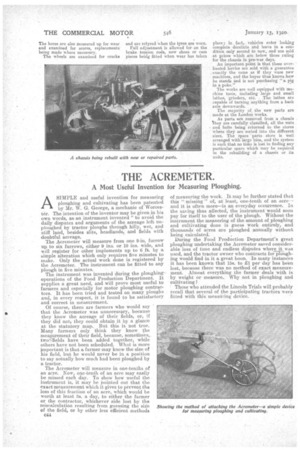THE ACREMETER.
Page 24

If you've noticed an error in this article please click here to report it so we can fix it.
A Most Useful Invention for Measuring Ploughing.
ASIMPLE and useful invention for measuring ploughing and cultivating has been patented by Mr. W. G. George, a mechanic of WorcestOr. The intention of the inventor may be given in his own words, as an instrument invented "to avoid the daily disputes and arguments of the acreage left unploughed by tractor ploughs through hilly, wet, and stiff land, besides slits, headlands, and fields with doubtful acreage.
The Am-meter will measure from one 9-in. furrow up to six furrows, either 9 ins. or 10 ins, wide, and will register for other implements up to 6 ft. by a simple alteration which only requires five minutes to make. Only the actual work done is registered by the Acremeter. The instrument can be fitted to any plough in five minutes. The instrument was invented diiring the ploughing. operations of the Food Production Department. It supplies a great need, and will prove most useful to farmers and especially for motor ploughing contractors. It has been tried and tested on many ploughs and, in every respect, it is found to be satisfactory and correct in measurement.
Of course there are farmers who would say that the Aerometer .was unnecessary, because they know the acreage of their fields, or, if they did not, they could obtain it by a glanCe at the statutory .map.. But this is not true. Many farmers only think they know the measurement of their field, because, sometimes,, twot-lelds have been added together, while others have not been scheduled. What is more important is that a Farmer may knew the size of his field, but he would never be in a position to sty actually how much had been ploughed by a tractor.
The Acremeter will measure in one-tenths of an acre. New, one-tenth of an acre may easily be missed each day. To show how useful the instrument is, it may be pointed Out that the exactmeasurement which it gives to prevent the loss of this fraction of an acre, which would be worth at least 3s. a day, to either the farmer or the contractor, whichever side lost by the miscalculation resulting from guessing the sine of the field, or by other less efficient methods C"
of measuring the work. It may be further stated that this " missing" of, at least, one-tenth of an acre-and it is often more—is an everyday occurrence., In the saving thus affected, the instrument would soon pay for itself to the user of the plough. Without the instrument the measuring of the amount of ploughing and cultivating done is guess work entirely, and thousands of acres are ploughed annually without being calculated.
During the Food Production Department's great ploughing undertaking the Acremeter saved considerable loss of time and endless disputes where it was used, and the tractor owner who contracts for piaghing would find in it a great boon. -In -many instances it has been known that 15s. to Li per day hasbeen lost, because there was no method of exact measurement. Almost everything the farmer deals with is by weight or measure.. Why not in ploughing and cultivating
Those who attended the Lincoln Trials will probably recall that several of the participating tractors were fitted with this measuring device.


























